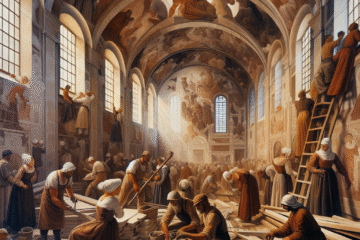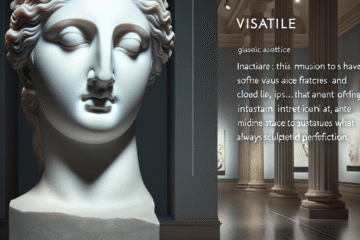Introduction: The Colors That Could Sing
Imagine a world where colors hum, shapes resonate like tones, and a canvas becomes an orchestral stage. For Wassily Kandinsky (1866–1944), this wasn’t imagination—it was experience. Recognized as one of the pioneers of abstract art, Kandinsky based his oeuvre on a unique fusion of senses known as synesthesia, where stimulation of one sensory pathway involuntarily triggers another. In his case, colors sounded and music painted images on the canvas of his mind. But Kandinsky’s genius was not limited to neurological phenomena. His artwork was a rich tapestry woven from spiritual philosophies, technological innovation, and cultural evolution. This article explores Kandinsky’s groundbreaking relationship with synesthesia, and how his inner symphonies helped transform modern visual art forever.
1. From Moscow to Munich: A Journey Into Artistic Intuition
Born in Moscow in 1866, Kandinsky originally pursued law and economics before making the radical decision, at age thirty, to study art in Munich. His early academic training in painting was shaped by Art Nouveau and Russian folk art, but even then, his sensitivity to color distinguished him. Significantly, Kandinsky believed he could hear colors and see sounds—a hallmark of synesthesia, though the concept had not yet gained scientific traction. This perception of the senses underpinned his conviction that visual art could evoke the same profound emotional responses as music, and set the stage for his break from representational art.
At the turn of the 20th century, symbolist and spiritualist movements were challenging scientific rationalism. Occult philosophies like Theosophy, especially the writings of Helena Blavatsky and Rudolf Steiner, greatly influenced Kandinsky’s vision. These teachings, which emphasized hidden spiritual realities and cosmic harmony, inspired Kandinsky to explore the ‘inner necessity’ of his art—an idea that would ultimately redefine the purpose of painting itself.
2. The Birth of Abstraction: Sound as a Visual Motif
In 1910, Kandinsky painted what is widely considered the first abstract watercolor—a composition devoid of recognizable imagery, relying solely on color, form, and rhythm. It was revolutionary. Rather than depicting the external world, these works aimed to communicate inner experiences. Just as notes come together to form a symphony, shapes and colors were orchestrated to convey emotional harmony or dissonance.
Kandinsky’s landmark treatise, “Concerning the Spiritual in Art” (1911), laid out his aesthetic theory in detail. He described how colors affect the soul, assigning psychological qualities to each—blue as spiritual, yellow as aggressive, red as vital. Drawing parallels between painting and music, he likened colors to musical instruments and compositions to harmonies. Each painting was a concert of the spirit, expressing invisible realities through visible means. This was not mere metaphor—Kandinsky’s synesthesia made this a living, sensory truth.
Technological advances in sound recording and optics during the early 20th century also mirrored Kandinsky’s experiments. The parallel evolution of cinema, chromatic theories from scientists like Hermann von Helmholtz, and the rise of experimental music from composers like Arnold Schoenberg (whom Kandinsky admired greatly), all converged to push traditional boundaries of perception and art.
3. The Bauhaus Period: Structure Meets Spirit
In 1922, Kandinsky joined the Bauhaus school in Germany, an institution founded by Walter Gropius that aimed to unify art, craft, and technology. Here, his ideas evolved further as he began integrating geometric forms—circles, triangles, lines—with his philosophical color theories. Though more rigorously structured, his paintings retained their musical undertones and spiritual objectives.
At the Bauhaus, Kandinsky collaborated with artists, architects, and designers striving to make art an integral, functional part of modern life. This period was marked by the increasing rationalization of art, yet Kandinsky maintained his metaphysical focus. His work provided a counterbalance to the machine aesthetic, infusing abstraction with emotion and inner resonance. His teaching legacy, including his ideas about synesthesia, influenced generations of artists and designers who passed through the Bauhaus doors—many of whom would go on to lead the mid-century modernist movement globally.
4. Inner Worlds During Outer Turmoil: Exile and Reflection
With the rise of Nazism and the closure of the Bauhaus in 1933, Kandinsky moved to France, where he continued to paint in relative isolation until his death in 1944. These final years were marked by a return to more biomorphic forms—less rigid than his Bauhaus geometry and more reminiscent of surrealist dreams. Despite the external chaos of World War II, Kandinsky’s work remained steadfastly invested in the inner world. He referred back to musical analogies, composing paintings like ‘Composition IX’ and ‘Composition X’ as visual operas where every line and shape vibrated with intention.
In these late works, we see an artist who had absorbed the pull of multiple eras—Symbolism, Expressionism, Constructivism—and synthesized them into a unique personal style. The idea that a painting could be a song of the soul, an echo of unseen dimensions, continued to define his creative impulse.
5. Legacy: Synesthesia in the Digital Age
Today, Kandinsky’s work resonates not only in museums but in disciplines ranging from neuroscience to digital art. Scientific research into synesthesia has confirmed its legitimacy, and artists increasingly explore cross-sensory experiences using technology—augmented reality, generative art, even brainwave-to-image translation techniques. Kandinsky’s once-mystical belief that a color could sound or a shape could ring now finds expression in data visualization and interactive art installations.
Moreover, the spiritual search at the core of Kandinsky’s practice continues to influence abstract painters, sound artists, and immersive media designers. As we navigate a world increasingly dominated by sensory integration—from multisensory branding to VR environments—Kandinsky’s dream of art transcending physical limits to touch the soul feels not only relevant, but prophetic.
Conclusion: The Eternal Symphony
Wassily Kandinsky saw the world not just with his eyes, but with an orchestral imagination that fused senses, philosophies, and eras. Through synesthesia, he discovered a universal language of emotion and spirituality—one that rejected the literal to embrace the eternal. More than a painter, Kandinsky was a visual composer, and his symphonies on canvas continue to resonate, reminding us that art can be heard, not just seen, if we open ourselves to its deeper frequencies.


